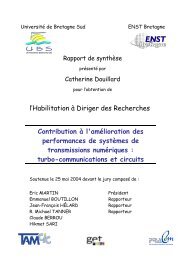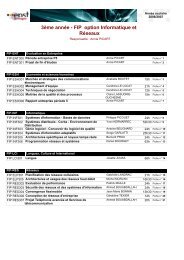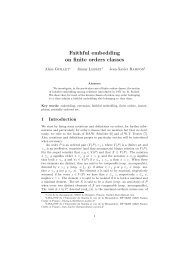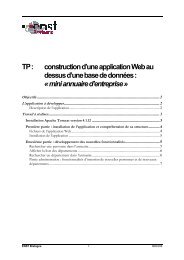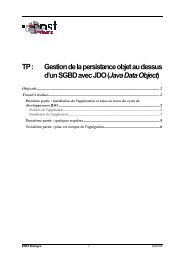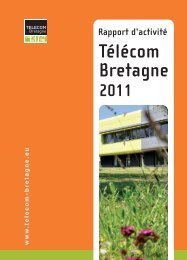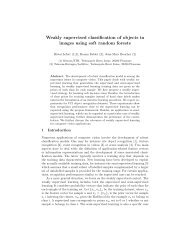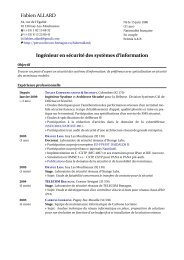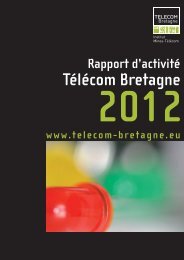researResearch - Télécom Bretagne
researResearch - Télécom Bretagne
researResearch - Télécom Bretagne
You also want an ePaper? Increase the reach of your titles
YUMPU automatically turns print PDFs into web optimized ePapers that Google loves.
h Research<br />
9<br />
RESEARCH<br />
Main achievements of the project<br />
Work carried out until now allowed us to<br />
consolidate the development of a simulator thanks<br />
to a more precise definition of underlying models<br />
through work on the regional project MOSISMAR,<br />
in collaboration with IETR (Rennes1 University)<br />
and the BOOST Technologies SME. Telecom<br />
<strong>Bretagne</strong> validated the algorithms (modelling of<br />
the SAR processing and of the hydrodynamic<br />
interactions) developed the previous year and also<br />
completed the geophysical modelling through<br />
other models of environmental phenomena.<br />
Modelling of the SAR processing module<br />
continued at IETR. Algorithms evolved from<br />
validation in the case of terrestrial environments<br />
to processing in the marine environment with the<br />
help of BOOST Technologies and the collaboration<br />
of other laboratories. In the final stage, the various<br />
elements (modules) were interconnected and the<br />
connexion was tested. However the aims outlined<br />
initially were not all accomplished, but they<br />
allowed us to build a solid proposition in the<br />
Brittany Maritime Cluster (competitiveness<br />
cluster).<br />
The MODENA project received recognition from<br />
the Brittany Maritime Cluster at the end of 2006.<br />
2007 was given over to research for finance for the<br />
project. We obtained finance from the DGE (and the<br />
FUI – Fond Unique Interministériel ie Unique Interministries<br />
fund), due to strong support from the<br />
DGA and the Brittany Maritime cluster for part of<br />
the project The Breton Region also funded the<br />
project. The project is jointly lead by ARTAL (for<br />
DGE requirements) and Telecom <strong>Bretagne</strong>. The<br />
partners of the project are either academic<br />
partners (Université de Rennes, Université de<br />
Nantes, Université de Brest and ENSIETA) or<br />
companies /SME (THALES, CLS/BOOST, MAREE,<br />
SATIMO). 2008 is formally the first year of the<br />
MODENA project. The aims of the project are more<br />
precisely defined in an accompanying document,<br />
available on demand. Complementary studies on<br />
analysis of the colour of surface water were<br />
carried out under an IFREMER contract.<br />
Besides, the GALILEOCEAN project, approved by<br />
the Brittany Maritime Cluster, is currently seeking<br />
funding.Being in a partnership consolidation<br />
phase, another project: “DTC France” has been<br />
developed in conjunction with BOOST<br />
Technologies, which has since become CLS. DTC<br />
France is a PEA type project on a DGA contract<br />
with ONERA – Thales as a co-contractor. We come<br />
into the project as a subcontractor of CLS in<br />
workpackage 2 (Predefinition of a SAR mode on<br />
satellite transmissions of opportunity in mono or<br />
multi-transmitters) and more precisely in bi-static<br />
reception and feasibility study of monotransmitter<br />
SAR images. This work was also<br />
carried out with other partners of the project,<br />
particularly the GEA (Groupe d’Electromagnétisme<br />
Appliqué, Applied Electromagnetism Group, EA<br />
3455) of Paris X University which focussed on the<br />
SAR multi transmitters imagery (multi static<br />
cases). The aim of our work was to study the<br />
feasibility and performance of a passive SAR<br />
(Synthetic Aperture Radar) detection system for<br />
terrestrial targets. Two types of transmitters of<br />
opportunity were studied<br />
• The GPS system satellites, which<br />
advantageously offer a large and permanent<br />
cover, allowing multistatism but have weak<br />
transmission power (-160 dBW in reception)<br />
and require long duration observation (low<br />
speed transmitters)<br />
• SAR civilian satellites, with higher speed and<br />
more power but offer intermittent and<br />
restrained cover. This contract is a<br />
complement to the MOPS (“Marine<br />
Opportunity Passive Systems “) project,<br />
presented and accepted at RTRA Europôle<br />
Mer (European Sea advanced research<br />
network).<br />
Finally 2008 saw the completion of the VIGISAT<br />
project, reception station which will be installed on<br />
the Telecom <strong>Bretagne</strong> site.<br />
Publications<br />
Articles in peer-review journals<br />
[1] Nicolas Bon, Ali Khenchaf, René Garello. GLRT subspace detection for<br />
range and Doppler distributed targets. IEEE transactions on aerospace<br />
and electronic systems, april 2008, vol. 44, n° 2, pp. 678-696<br />
[2] Jean-Marc Le Caillec. Hypothesis testing for nonlinearity detection<br />
based on an MA model. IEEE transactions on signal processing, february<br />
2008, vol. 56, n° 2, pp. 816-821<br />
[3] Jean-Marc Le Caillec. Time series modeling by a second Order<br />
Hammerstein system. IEEE transactions on signal processing, january<br />
2008, vol. 56, n° 1, pp. 96-110<br />
[4] Frédéric Maussang, Michèle Rombaut, Jocelyn Chanussot, Maud<br />
Amate. Fusion of local statistical parameters for buried underwater<br />
mine detection in sonar imaging. EURASIP journal on advances in signal<br />
processing, 2008, vol. 2008<br />
Thesis<br />
[5] Vincent Gras. Caractérisation de la signature radar de la surface<br />
océanique et son application à la détection d'objets flottants. Th. doct. :<br />
Traitement du signal et télécommunications: Université de Rennes 1<br />
Institut Télécom ; Télécom <strong>Bretagne</strong> : 2008, 2008telb0068. 197 p.<br />
197



